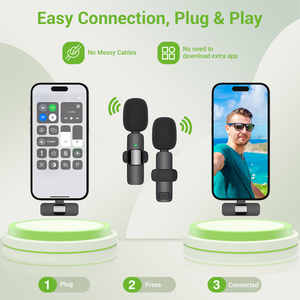
All categories
Featured selections
Trade Assurance
Buyer Central
Help Center
Get the app
Become a supplier

(2817 products available)



















































A microphone splitter is a device that divides a single microphone signal into multiple outputs. It allows one source to send its audio signal to several destinations. There are a few different kinds of microphone splitters, each with unique qualities and advantages.
Passive splitter:
A passive microphone splitter is a simple version that uses resistors to divide the signal. It is a low-cost and durable option for distributing a microphone signal. However, because it just uses passive components, the splitter's signal may be diminished.
Active splitter:
Active microphone splitters use transistors or operational amplifiers (op-amps) to boost or buffer the microphone signal. As a result, there is better control over the signal level, minimizing any loss or degradation in sound quality. An active splitter offers separate outputs when combining multiple microphones into one output. The output from each channel can go to a different piece of recording equipment.
Transformer isolated:
This kind of microphone splitter uses a transformer to separate the channels. This method can help reduce ground loops and other noise issues in audio systems. It is particularly beneficial in live sound environments where many microphones feed into a mixing console.
The model also helps to keep the different systems electrically isolated. This keeps the output signals from interfering with one another. This kind of splitter is usually active and benefits from the transformer.
DI box (direct injection box):
A DI box can also be seen as a microphone splitter. It is a device that takes a high-impedance, instrument-level signal and converts it to a low-impedance, mic-level signal. This conversion allows the instrument signal to be sent to a mixer or recording device. It typically has a quarter-inch plug for the instrument signal and an XLR output for the mic-level signal.
Some DI boxes have both a quarter-inch output and an XLR output, which can allow the signal to go to a mixer and a recording device simultaneously.
Some more sophisticated DI boxes can switch between different types of outputs, including effects loop outputs, line-level outputs, and aux outputs. These additional outputs can function similarly to a microphone splitter by allowing one signal to go to multiple destinations.
To guarantee that the varied demands of customers are satisfied, microphone splitter adapters have a variety of characteristics and functions. They consist of;
Microphone splitters have various uses; in entertainment, multiple people can speak simultaneously to a broadcast or recording. This is helpful in situations like live news interviews, podcasts, and sound engineering, where one device needs to receive signals from many sources. Additionally, many amateur sound directors and musicians use mic splitters to provide backup links to a speaker or music at events and performances.
Security systems also employ microphone splitters to enhance their listening abilities. Mic splitters allow their recording devices to capture audio from many microphones across a large area to detect any potential hazards or security breaches.
Another use for microphone splitters is gaming. Not all controllers or PCs allow for headset usage, so a mic splitter can be used to separate the audio output and input into two distinct jacks, thus enabling the gamer to use the headset with all its functions intact. Furthermore, gamers often record and stream their gameplay, and a mic splitter can allow them to use a single headset for both insonation and communication with other players. This happens when a splitter allows the incorporated microphone and headphones to be plugged into one port.
A microphone cable splitter can be used in musical stings to mix two instruments or voices into one channel. For example, in a situation where two guitarists want to record a duet using one mic, a splitter cable can be used so that both their inputs go to a single output. Similarly, it can also be used to combine two mics into a single recording device in a podcast setting.
When selecting a microphone splitter to purchase, buyers should consider their needs and take the following factors into account.
Q1: Will a microphone splitter work with any microphone?
A1: This depends on the type of microphone being referred to. Microphone splitters generally split the output of a microphone, which comes from a micro 1/8 TRS (Tip Ring Sleeve) or XLR connector to two outputs. It is important to note that not all microphones have the capacity to use microphone splitters. Check if the microphone has the required plug type, as splitters cannot divide signals if both microphones try to use the same XLR cable.
Q2: How to choose a microphone splitter?
A2: Consider the number of outputs required; different splitters offer various output ports. Ensure that the device or software the microphones will be connected to is compatible. Check if the microphones have the appropriate plug type that the splitter can provide. It is important to read reviews before purchasing to see if other users' experiences aligning with the intended use.
Q3: Can multiple microphone splitters be used?
A3: Yes, it is possible to connect multiple microphone splitters, but there are some important considerations to keep in mind. Each splitter takes one of its output sockets to plug into the next splitter. This can lead to a decrease in sound quality and an increase in cost. To minimize sound quality, make sure to purchase high-quality splitters.
Q4: Is it possible to use a microphone splitter on a USB microphone?
A4: Microphone splitters are designed primarily for analog microphones, so their functionality may be limited when attempting to use them with a USB microphone. USB microphones require a digital connection to a computer or recording device, while microphone splitters provide an analog output.